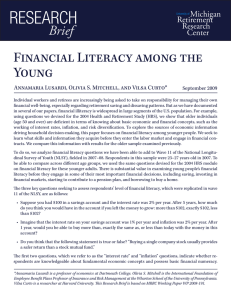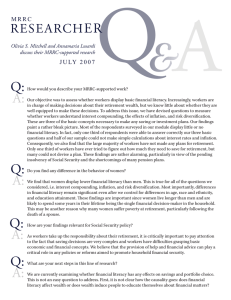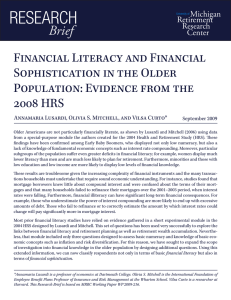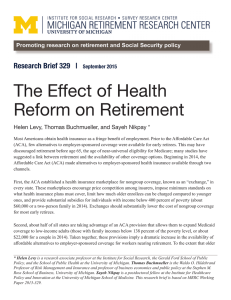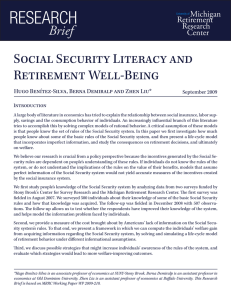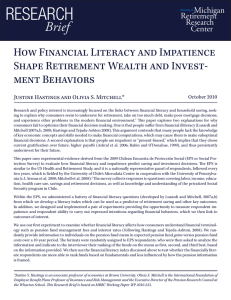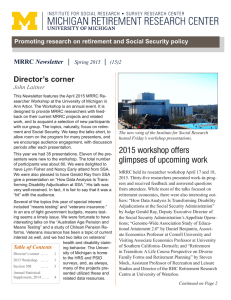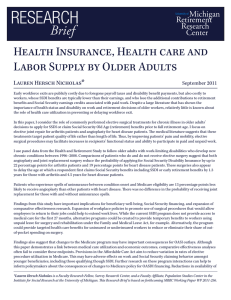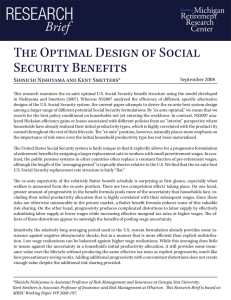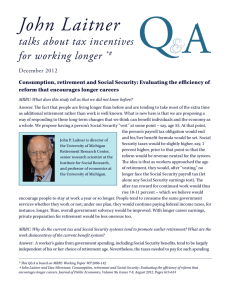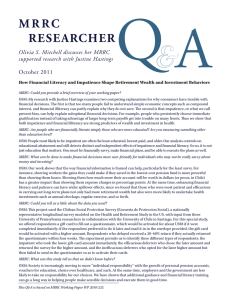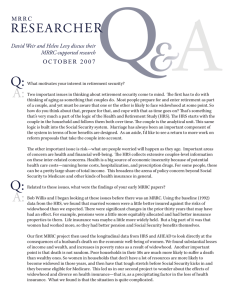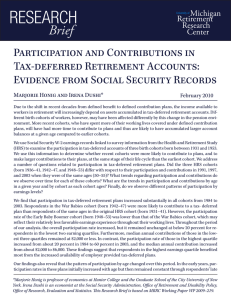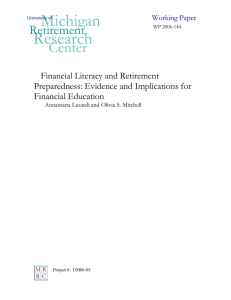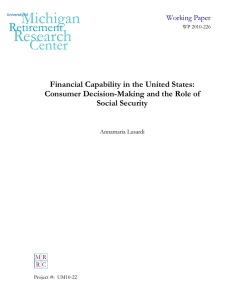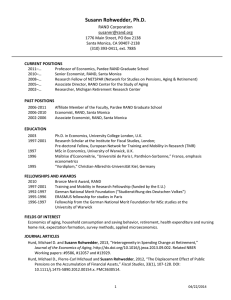ReseaRch Brief Financial Capability in the United States: Consumer Decision-Making
advertisement
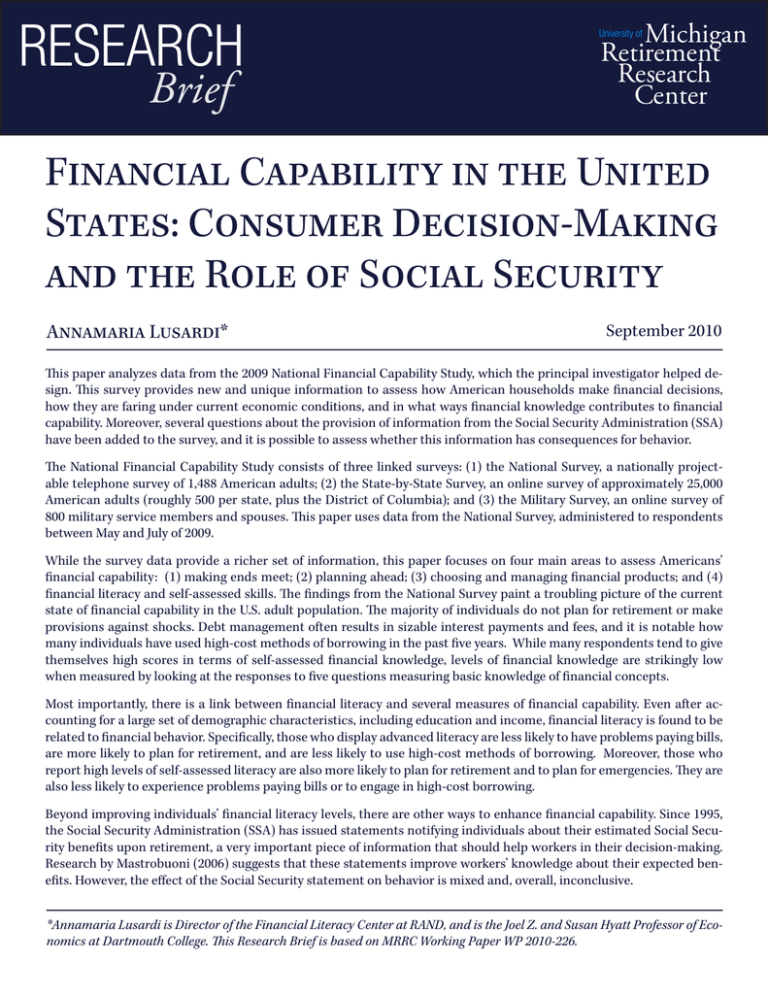
ReseaRch Brief Michigan Retirement Research Center University of Financial Capability in the United States: Consumer Decision-Making and the Role of Social Security Annamaria Lusardi* September 2010 This paper analyzes data from the 2009 National Financial Capability Study, which the principal investigator helped design. This survey provides new and unique information to assess how American households make financial decisions, how they are faring under current economic conditions, and in what ways financial knowledge contributes to financial capability. Moreover, several questions about the provision of information from the Social Security Administration (SSA) have been added to the survey, and it is possible to assess whether this information has consequences for behavior. The National Financial Capability Study consists of three linked surveys: (1) the National Survey, a nationally projectable telephone survey of 1,488 American adults; (2) the State-by-State Survey, an online survey of approximately 25,000 American adults (roughly 500 per state, plus the District of Columbia); and (3) the Military Survey, an online survey of 800 military service members and spouses. This paper uses data from the National Survey, administered to respondents between May and July of 2009. While the survey data provide a richer set of information, this paper focuses on four main areas to assess Americans’ financial capability: (1) making ends meet; (2) planning ahead; (3) choosing and managing financial products; and (4) financial literacy and self-assessed skills. The findings from the National Survey paint a troubling picture of the current state of financial capability in the U.S. adult population. The majority of individuals do not plan for retirement or make provisions against shocks. Debt management often results in sizable interest payments and fees, and it is notable how many individuals have used high-cost methods of borrowing in the past five years. While many respondents tend to give themselves high scores in terms of self-assessed financial knowledge, levels of financial knowledge are strikingly low when measured by looking at the responses to five questions measuring basic knowledge of financial concepts. Most importantly, there is a link between financial literacy and several measures of financial capability. Even after accounting for a large set of demographic characteristics, including education and income, financial literacy is found to be related to financial behavior. Specifically, those who display advanced literacy are less likely to have problems paying bills, are more likely to plan for retirement, and are less likely to use high-cost methods of borrowing. Moreover, those who report high levels of self-assessed literacy are also more likely to plan for retirement and to plan for emergencies. They are also less likely to experience problems paying bills or to engage in high-cost borrowing. Beyond improving individuals’ financial literacy levels, there are other ways to enhance financial capability. Since 1995, the Social Security Administration (SSA) has issued statements notifying individuals about their estimated Social Security benefits upon retirement, a very important piece of information that should help workers in their decision-making. Research by Mastrobuoni (2006) suggests that these statements improve workers’ knowledge about their expected benefits. However, the effect of the Social Security statement on behavior is mixed and, overall, inconclusive. *Annamaria Lusardi is Director of the Financial Literacy Center at RAND, and is the Joel Z. and Susan Hyatt Professor of Economics at Dartmouth College. This Research Brief is based on MRRC Working Paper WP 2010-226. The Financial Capability Survey provides a direct way to test whether individuals are affected by the information provided by SSA. The survey contains the following three questions: 1. In the past 12 months, have you received a statement from the Social Security Administration that tells you how much money you can expect to receive from Social Security when you retire? 1. Yes; 2. No; 3. DK; 4. Refuse 2. [If received statement (C12 =1)] Have you used the information to decide or adjust your decision about when to stop working? 1. Yes; 2. No; 3. DK; 4. Refuse 3. [If received statement (C12 = 1)] Have you used the information to decide or adjust your decision about when to claim your Social Security benefits? 1. Yes; 2. No; 3. DK; 4. Refuse About 65 percent of respondents indicated receiving a statement from Social Security, but there are large differences among income groups: only 37 percent of those with income below $25,000 acknowledge receiving the statement versus 86 percent of those with income above $75,000. However, the statement seems to play a role in individuals’ retirement decisions and choices about when to claim Social Security benefits: as many as 25 percent of those who acknowledge receiving statements stated they have used them in their decision about when to claim Social Security benefits. Moreover, 21 percent stated they have used the statement to make their decision about when to stop working. Also, there are large differences in usage among demographic groups and some of the more vulnerable populations. Even after accounting for a large set of demographic characteristics and income, African-Americans are those more likely to use the statement to make decisions about retirement and when to claim Social Security benefits. Marital status also plays a role: those who are single or separated from a spouse are more likely to use the statement for their decisionmaking. Since these are individuals who may face more difficult economic circumstances, we might conclude that the statement seems to have an impact on some vulnerable groups. Those with more children are less likely to use the statement in their decision-making, perhaps because their choices are more constrained. Those hit by a large decrease in income are more likely to use the statement to decide when to withdraw Social Security benefits; given the severity of the financial crisis, it seems that the statement has been of use to those who have faced economic difficulties. Age is again an important factor, and the use of the statement is heavily dependent on age. To consider the fact that the statement may be more relevant for those not very far away from retirement, I have also restricted the sample to those older than 50. One notable result is that African-Americans are still more likely to use the statement for their financial decisions. Financial literacy is also a predictor for using the statement, supporting evidence that one needs basic knowledge to make sound financial decisions. This research is informative for policy in several ways. First, the analysis indicates which groups are most prone to poor financial decision-making and whether greater financial literacy enhances financial capability. Second, it is possible to evaluate the effect of information about Social Security benefits on consumer behavior. Finally, findings from this research could be used to design financial education programs that are more effective in fostering financial capability. University of Michigan Retirement Research Center Institute for Social Research 426 Thompson Street Room 3026 Ann Arbor, MI 48104-2321 Phone: (734) 615-0422 Fax: (734) 615-2180 mrrc@isr.umich.edu www.mrrc.isr.umich.edu The research reported herein was performed pursuant to a grant from the U.S. Social Security administration (SSA) through the Michigan Retirement Research Center (MRRC). The findings and conclusions expressed are solely those of the author(s) and do not represent the views of SSA, any agency of the federal government, or the MRRC. Regents of the University of Michigan: Julia Donovan Darlow, Laurence B. Deitch, Denise Ilitch, Olivia P. Maynard, Andrea Fischer Newman, Andrew C. Richner, S. Martin Taylor, Katherine E. White, Mary Sue Coleman, Ex Officio
